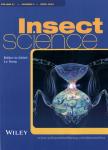Oviposition preference of swallowtail butterfly, Papilio polytes (Lepidoptera Papilionidae) on four Rutaceae (Sapindales) host plant species
Oviposition preference of swallowtail butterfly, Papilio polytes (Lepidoptera Papilionidae) on four Rutaceae (Sapindales) host plant species作者机构:School of Biological Sciences Universiti Sains Malaysia 11800 Penang Malaysia Department of Biology Faculty of Science University Syiah Kuala 23111 Banda Aceh Indonesia University of Florida IFAS. Mid-Florida Research and Education Center 2725 Binion Road Apopka FL 32703-8504 USA
出 版 物:《Insect Science》 (昆虫科学(英文版))
年 卷 期:2010年第17卷第4期
页 面:369-378页
核心收录:
学科分类:07[理学] 09[农学] 0904[农学-植物保护] 090402[农学-农业昆虫与害虫防治] 0713[理学-生态学]
主 题:Citrus aurantifolia Citrus hystrix Citrus reticulata Murraya koenigii ovipo-sition preference Papilio polytes
摘 要:Oviposition preference and egg deposition site selection by the butterfly, Papilio polytes L. (Lepidoptera: Papilionidae) on four rutaceous host plants, Citrus aurantofolia (Christm.) Swing., Citrus hystrix DC., Citrus reticulata Blanco, and Murraya koenigii (L.) Sprengel, were assessed in field cages measuring 2 × 2 ×2 m. Simultaneous two-choice and four-choice oviposition tests of whole host plants were conducted. The mean total number of eggs laid per plant on C. reticulata in the two-choice test was significantly higher (P 〈 0.01) than those on C. aurantifolia, C. hystrix, andM. koenigii. Among the three other host plants, C. aurantifolia was preferred over C. hystrix, and M. koenigii (P 〈 0.01) and C. hystrix was preferred over M. koenigii (P 〈 0.01). In the four-choice test, C. reticulata was highly preferred and significantly different from C. hystrix and M. koenigii. However, no oviposition preference was detected with C. aurantifolia. Among the various plant parts in the two- and four-choice tests, eggs on leaves of each plant were the highest, followed by numbers on stems, and negligible numbers on pots. These numbers on leaves of C. reticulata and C. aurantifolia were not significantly different (P 〉 0.05), but differed significantly (P 〈 0.01) from those on leaves of C. hystrix and M. koenigii. The quantitative trend of egg-laying on stems was very similar to that observed for the leaves. Papilio polytes showed strong preference to lay eggs on the underside of leaves of all host plants than on the upper side or on the petiole. More eggs were laid on the upper side of each host plant than on its petiole. The four host plants in descending order of preference were C. reticulata 〉 C. aurantifolia 〉 C. hystrix 〉 M. koenigii. Although M. koenigii was the least preferred, it has the potential to serve as an alternative host plant for P. polytes which can be manipulated when necessary, to alleviate the infestation of this pest to the citrus industry.



